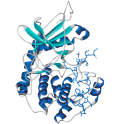
- Remove this product from my favorite's list.
- Add this product to my list of favorites.
Products
Newsletter
 |  |  |  |  |  |

Background: cAMP-dependent protein kinase ( PKA) is an ubiquitous serine/theonine protein kinase present in a variety of tissues (e.g. brain, skeletal muscle, heart) regulating several cellular responses by altering the interaction between the catatytic C and regulatory R subunits of PKA. The inactive tetrameric PKA holoenzyme R2C2 is activated when cAMP binds to R2, which dissociates the tetramer to R2*cAMP4 and two active catalytic subunits. Free Catalytic subunits of PKA can phosphorylate a variety of intracellular target proteins. In response to hormone-induced high cAMP levels, PKA phosphorylates glycogen synthetase (inhibition of the enzyme activity) and phosphorylase kinase to block glycogen synthesis.
The α-isoform is the predominant form with a broad tissue distribution and can be used for in vitro enzymological studies of neural and hormonal signal transduction or to phosphorylate target proteins in vivo (via microinjection) including ion channels, transcriptional activator proteins and regulatory enzymes of glycogen metabolism.
Highly active PKA catalytic subunit recombinantly expressed in E. coli and purified using several chromatographic steps. Preferred peptide substrate is kemptide (LRRASLG).
Theoretical MW: 41 kDA
Expression system: E. coli
Storage buffer: 20mM MOPS pH7, 150mM NaCl, 1mM DTT, 1mM EDTA, 50% Glycerin
Purity: >95% (SDS-PAGE)
Protein concentration: 0.16 mg/ml (Bradford method using BSA as standard protein)
Specific activity : >8,000,000 U/mg (based on kemptide phosphorylation, 1 unit is defined as 1 pmol phosphate per mg and minute.)
Entrez Gene ID: 5566
UniProtKB: P17612
Ordering information: shipped on dry ice
Figure: Real-time kinetic analysis of kinase inhibitor H-89 binding to PKA Cα using surface plasmon resonance.
Please contact our application specialists to obtain more information and an individual quote tailored to your specific needs.
Taylor SS (1989) "cAMP-dependent protein kinase. Model for an enzyme family" J. Biol. Chem. 264(15):8443-6
Taylor SS, Buechler JA, Yonemoto W (1990) "cAMP-dependent protein kinase: framework for a diverse family of regulatory enzymes" Annu. Rev. Biochem. 59:971-1005
Walsh DA, Glass DB, Mitchell RD (1992) "Substrate diversity of the cAMP-dependent protein kinase: regulation based upon multiple binding interactions" Curr. Opin. Cell Biol. 4(2):241-51
Sculptoreanu A, Rotman E, Takahashi M, Scheuer T, Catterall WA (1993) "Voltage-dependent potentiation of the activity of cardiac L-type calcium channel alpha 1 subunits due to phosphorylation by cAMP-dependent protein kinase" Proc. Natl. Acad. Sci. U S A 90 (21): 10135-9
Walsh DA, Van Patten SM (1994) "Multiple pathway signal transduction by the cAMP-dependent protein kinase" FASEB J. 8(15):1227-36
Tasken K, Skalhegg BS, Jahnsen T et al. (1997) "Structure, function, and regulation of human cAMP-dependent protein kinases" Adv. Second Messenger Phosphoprotein Res. 31:191-204
Gray PC, Scott JD, Catterall WA (1998) "Regulation of ion channels by cAMP-dependent protein kinase and A-kinase anchoring proteins" Curr. Opin. Neurobiol. 8(3):330-4
Leandro J1, Simonsen N, Saraste J, Leandro P, Flatmark T. (2011) "Phenylketonuria as a protein misfolding disease: The mutation pG46S in phenylalanine hydroxylase promotes self-association and fibril formation." Biochim Biophys Acta. 2011 Jan;1812(1):106-20.
Fischer JJ, Dalhoff C, Schrey AK, Graebner OY, Michaelis S, Andrich K, Glinski M, Kroll F, Sefkow M, Dreger M, Koester H. (2011) "Dasatinib, imatinib and staurosporine capture compounds - Complementary tools for the profiling of kinases by Capture Compound Mass Spectrometry (CCMS)." J Proteomics. 75(1):160-8.
Kim SH, Jung SH, Kong DH, Jeon HY, Kim MS, Han ET, Park WS, Hong SH, Kim YM, Ha KS (2016) "Sensitive array-based assay for determination of serological protein kinase A autoantibody levels based on its antigen protein activation."Clin Biochem. 2016 Jan;49(1-2):127-31.
Morschheuser L1, Mükusch S2, Riedner M3, Seitz H4, Rohn S5 (2016) "High-performance thin-layer chromatography as a fast screening tool for phosphorylated peptides."J Chromatogr B Analyt Technol Biomed Life Sci. 1008:198-205.
Boonpawa R, Spenkelink A, Punt A, Rietjens IMCM. (2017) "Physiologically based kinetic modeling of hesperidin metabolism and its use to predict in vivo effective doses in humans." Mol Nutr Food Res. 61(8).
Antonio Pellegrino, Sandra Mükusch, Viola Seitz, Christoph Stein, Friedrich W Herberg, Harald Seitz (2022), "Transient Receptor Potential Vanilloid 1 Signaling Is Independent on Protein Kinase A Phosphorylation of Ankyrin-Rich Membrane Spanning Protein", Med Sci (Basel);10(4):63. doi: 10.3390/medsci10040063.
Darja Lavogina, Naila Nasirova, Tanel Sõrmus, Taavo Tähtjärv, Erki Enkvist, Kaido Viht, Tõiv Haljasorg, Koit Herodes, Jana Jaal, Asko Uri (2023) "Conjugates of adenosine mimetics and arginine-rich peptides serve as inhibitors and fluorescent probes but not as long-lifetime photoluminescent probes for protein arginine methyltransferases"J Pept Sci 29(3):e3456. doi: 10.1002/psc.3456. Epub 2022 Oct 28.
Recombinant human cAMP-dependent protein kinase: PKA, RI alpha, 25 µg - 295,00 €
Recombinant human cAMP-dependent protein kinase: PKA, holo type I alpha, 25 µg - 295,00 €
Recombinant human cAMP-dependent protein kinase: PKA, RII alpha, 25 µg - 295,00 €
Recombinant cAMP-dependent protein kinase: PKA, holo type II alpha, 25 µg - 295,00 €
PKI, 100 µg - 125,00 €
Welcome Login
Contact us
Follow us